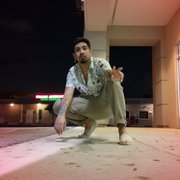Jeremy E.
Google
The barista's mop squeaks rhythmically across the polished concrete floor as I wait—and wait—for my morning cortado at the Starbucks on East Columbus Avenue in Springfield, Massachusetts. Twenty-five minutes later, I'm still waiting, watching a steady stream of drive-thru customers receive their orders while my simple drink remains mysteriously elusive.
This isn't just any Starbucks. It sits in a city that knows something about resilience. Fourteen years ago, an EF-3 tornado with 160-mph winds carved a 38-mile path of destruction through Springfield, leveling 500 buildings and reshaping the landscape where this coffee shop now stands. That the location exists at all is a testament to the city's remarkable recovery—even if the service doesn't always match the effort.
The interior is undeniably handsome: warm wood-slat ceilings, hexagonal tiles in muted grays, and a striking coffee plantation mural that spans an entire wall. It's Starbucks' contemporary design language at its most refined, creating the kind of third-place atmosphere the company promises. The problem is execution.
During my 45-minute visit, I witnessed a curious phenomenon. Despite having six employees working, the handful of in-store customers seemed invisible compared to the endless parade of cars circling the drive-thru. Mobile orders materialized instantly; walk-in requests vanished into a void. When I finally received my cortado, it tasted suspiciously like steamed milk with a coffee suggestion.
The confusion starts before you even order. Many visitors arrive expecting to find the Starbucks that once occupied MGM Springfield's lobby, only to discover that location was replaced by a VIP lounge for high-roller gamblers. This standalone location, while geographically close to the $960 million casino complex, operates independently—and, based on reviews, problematically.
Springfield itself deserves better. This city of 154,000 has reinvented itself as a destination, anchored by the gleaming MGM resort and the Basketball Hall of Fame. The downtown pulses with new energy, and Columbus Avenue has emerged as a commercial corridor connecting these attractions. Yet this Starbucks, positioned to capture that flow, seems determined to test customers' patience.
The demographic reality is complex. Springfield's population is 46% Hispanic and Latino, with a median age of 33 and significant economic diversity. This should be exactly the kind of community where Starbucks' community coffeehouse model thrives. Instead, it's become a case study in how operational failures can undermine thoughtful design and strategic positioning.
What makes this particularly frustrating is the location's obvious potential. The building is modern and well-appointed, with ample parking and highway visibility. The bones are excellent; the execution is mystifying.
For travelers passing through Springfield—perhaps en route to the Berkshires or stopping at MGM—this Starbucks serves as an unintentional metaphor for American service culture. Beautiful spaces, premium pricing, and profoundly underwhelming delivery.
My advice: If you're staying at MGM Springfield, use the hotel's coffee options or visit the Gelato & Espresso counter in the South End Market. If you're a coffee purist willing to venture beyond chains, Springfield's downtown offers alternatives worth exploring.
But if you do find yourself at 1089 East Columbus Avenue, arm yourself with patience and low expectations. Consider it a lesson in resilience—both the city's and your own. Springfield rebuilt from devastating natural disaster; surely you can survive subpar coffee service.
Just don't expect it to be quick.






























